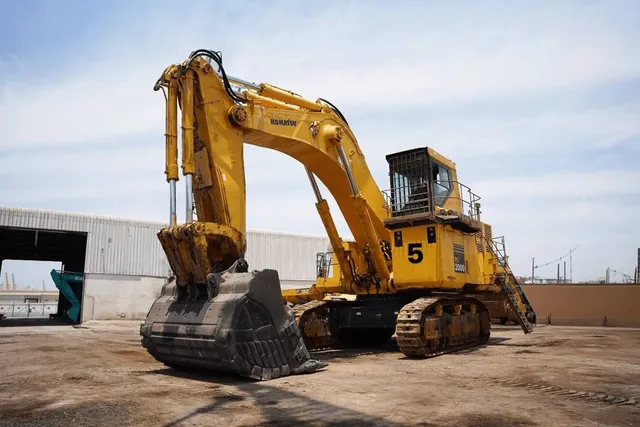Explore Top Used Construction Equipment: Reliable, Cost-Effective Solutions for Your Next Building Project
Foundation laying is a crucial phase in any construction project, serving as the structural base upon which the entire building or infrastructure is built. It requires precision, strength, and efficiency, all of which depend heavily on the right machinery. Here are some of the most commonly used machines for foundation laying, each tailored to handle specific tasks and challenges on site.
Excavators
Excavators are the backbone of foundation work, used extensively for digging trenches, holes, and foundations. These versatile machines are equipped with powerful hydraulic arms and buckets, making them ideal for removing soil, rocks, and debris.
Crawler Excavators: Known for their stability and traction, crawler excavators are commonly used in digging large foundation pits, even on uneven or muddy surfaces. Their robust undercarriage allows them to work efficiently in challenging terrains, ensuring precision in excavation depth and alignment.
Mini Excavators: Mini excavators are preferred for smaller projects or sites with limited space, such as urban construction or residential foundation work. They offer easy maneuverability and can access tighter areas without compromising on digging capacity.
Pile Drivers
Pile drivers are essential for deep foundation construction, especially for projects involving high-rise buildings, bridges, or heavy industrial structures. They drive piles—long, sturdy columns made of steel, concrete, or wood—into the ground to provide additional support and stability.
Hydraulic Pile Drivers: These machines use hydraulic systems to drive piles deep into the ground, making them efficient and powerful for handling large loads. They are particularly useful in conditions where soil strength varies or is unstable.
Vibratory Pile Drivers: Designed for driving piles quickly, vibratory pile drivers use vibrations to reduce friction and penetrate the ground more easily. They are often used in sandy or loose soils where traditional pile driving methods may be less effective.
Drilling Rigs
Drilling rigs are critical in foundation work, especially for projects that require deep, stable foundations. They are used to bore holes for piles, caissons, and other deep foundation elements.
Rotary Drilling Rigs: These machines are commonly used for creating boreholes in rock or hard soil layers. They use rotary cutting tools to penetrate the ground, making them ideal for deep foundation work in challenging conditions.
CFA (Continuous Flight Auger) Drilling Rigs: CFA rigs are used for drilling and pouring concrete simultaneously, creating continuous, cast-in-place piles. This method is efficient for foundations in urban areas, as it minimizes noise and vibration while ensuring rapid construction.
Bulldozers
Bulldozers are indispensable in clearing and preparing the foundation site before any digging or drilling begins. Their powerful blades push large amounts of soil, debris, and other materials to create a level surface, which is essential for accurate foundation laying.
Crawler Bulldozers: With excellent traction and weight distribution, crawler bulldozers are often used on uneven or soft ground, making them perfect for initial site preparation and leveling.
Mini Bulldozers: These smaller versions of bulldozers are used in confined areas where maneuverability is critical, such as residential foundations or sites with limited access.
Loaders
Loaders are used to move excavated soil, gravel, and other materials away from the foundation site or to load them into dump trucks for removal. They play a vital role in clearing the site and transporting materials efficiently.
Wheel Loaders: With their large buckets and high mobility, wheel loaders are ideal for moving bulk materials quickly, which is crucial for maintaining the pace of foundation work.
Skid Steer Loaders: Compact and highly maneuverable, skid steer loaders are used for smaller foundation projects or tight spaces. They are versatile, with attachments that can be swapped out for various tasks like grading, backfilling, and material handling.
Concrete Mixers and Pumps
Concrete mixers and pumps are essential in foundation work, especially when laying concrete foundations or building footings. They ensure the rapid and efficient mixing, transport, and pouring of concrete.
Truck-Mounted Concrete Mixers: These mixers deliver fresh concrete directly to the foundation site, reducing the time and labor required for concrete placement. They are commonly used for large-scale foundation pours.
Concrete Pumps: Concrete pumps, including boom pumps and line pumps, are used to transport concrete to hard-to-reach areas within the foundation site. They ensure precise placement of concrete, making them ideal for deep foundations, caissons, or areas with complex layouts.
Compactors
Compactors are vital for compressing soil, sand, or gravel layers, ensuring a stable base for the foundation. They help prevent future settlement or shifting of the building structure.
Plate Compactors: Used for compacting granular soils or gravel, plate compactors are ideal for small to medium-sized foundation works, providing a firm base for concrete pouring.
Roller Compactors: For larger areas, roller compactors are used to compress the sub-base layers more effectively, ensuring maximum soil density and reducing the risk of foundation failure.
Trenchers
Trenchers are used to dig trenches for utility lines, drainage systems, and footings within the foundation area. They are designed to cut through various soil types quickly, creating uniform trenches for accurate foundation work.
Chain Trenchers: These trenchers use a digging chain to cut through soil, making them suitable for deeper, narrower trenches needed for foundations.
Wheel Trenchers: Equipped with a toothed metal wheel, wheel trenchers are effective for cutting through harder soils and rocky terrains, providing the necessary trenching for foundation elements.
The success of foundation laying relies heavily on the proper use of these machines, each serving a specific purpose to ensure structural stability, safety, and efficiency. From excavation and drilling to concrete placement and soil compaction, these machines are indispensable for constructing strong, lasting foundations across various projects. By selecting the right machinery for the job, contractors can optimize productivity, maintain quality, and ensure the safety of the structures they build.





